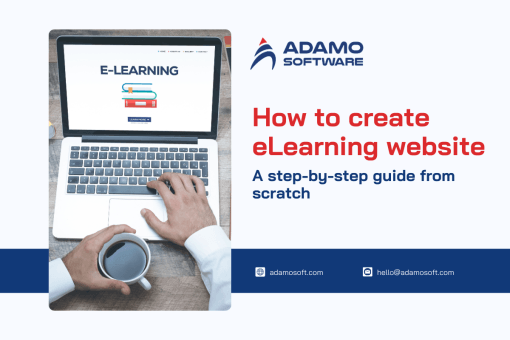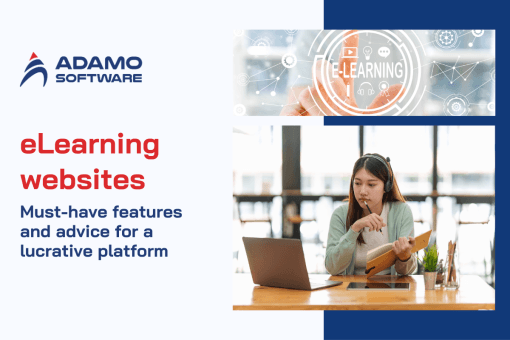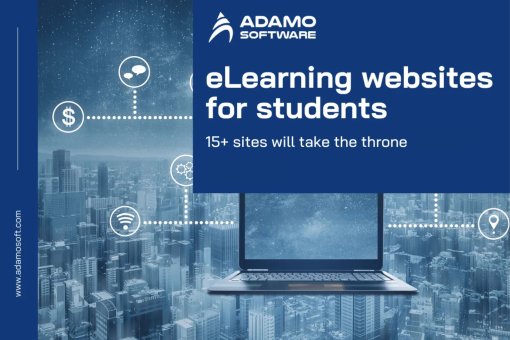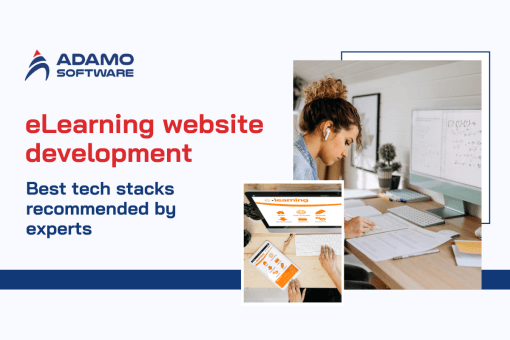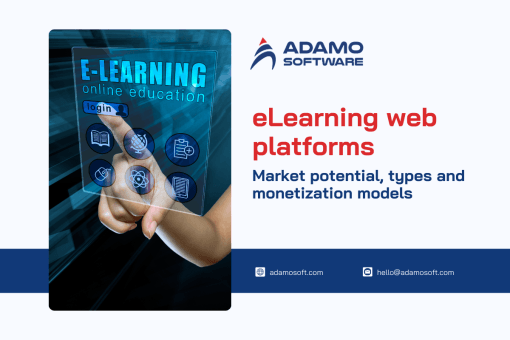Learning management system features: Discover the must-have list for effective eLearning

The main point of eLearning design is the learning management system features. It delivers learning experiences. LMS platforms help organizations manage, monitor, and evaluate training. However, not all LMS platforms are equal. Certain critical features make a difference. Without knowing these features, an LMS may fail to meet the needs of your business or education.
In this article, you will learn the basics of learning management systems and their benefits. We will cover the top 30 learning management system features that enhance online learning. This guide will help you choose the best LMS for your organization. Finally, we will discuss how Adamo Software can help you achieve your desired results. By the end, you should better understand how to choose an LMS.
I. Types of learning management systems
Before choosing the LMS, you must know the various categories of LMSs for e-learning. Each type is designed for a specific purpose and provides different learning management system features. Here are the most common types of learning management systems:

1. Cloud-based LMS
A cloud-based LMS, or SaaS LMS, is hosted on the internet. It is web-based and can be used without downloading any software. Another benefit that defines the functionality of the cloud-based LMS is its availability. Learners and administrators can cover courses and manage content anytime and anywhere. They are also easy to update and maintain. This makes them preferred in most business firms and even educational institutions.
2. Self-hosted LMS
Self-hosted LMS systems are on the user’s server, not the cloud. This type offers more regulations and settings for customization. Another advantage of a self-hosted LMS is the flexibility to manage and individualize a learning management system. However, implementing and updating content needs technical support. This can be a bit expensive for small business organizations since they will need to employ the services of IT professionals to do so.
3. Open-source LMS
Open-source LMS is the same as self-hosted ones, but the software can be downloaded and altered for free. It offers high customization because everyone has access to the source code. Some of the characteristics of an open-source system meant for learning are the availability of many plugins and an active community. As you will see, LMS platforms which are open source are highly versatile. Their implementation and maintenance require special technical assistance. Therefore, you will need your IT team to be highly specialized.
4. Corporate LMS
Corporate LMS platforms focus on the companies’ employee learning processes. Some effective learning management system features include performance monitoring, compliance solutions, and HR applications integration. The key concerns of corporate LMS are to enhance employees’ professional competence, guarantee industries’ compliance, and facilitate ongoing professional development.
5. Academic LMS
Academic LMS systems are designed for schools and universities education sectors. They focus on well-scheduled courses, customer support, and instructor-led training. Specific features include grading tools, student assessment tools, and communication tools like discussion forums and group projects.
Each type of these learning management system features meets the needs of different businesses or educational institutions. Understanding these differences helps you choose the best system for your eLearning goals.
II. The value of LMS features
LMS functionality and effectiveness rely on learning management system features. These features make courses manageable, captivate learners, and allow the administrators to monitor the progress.
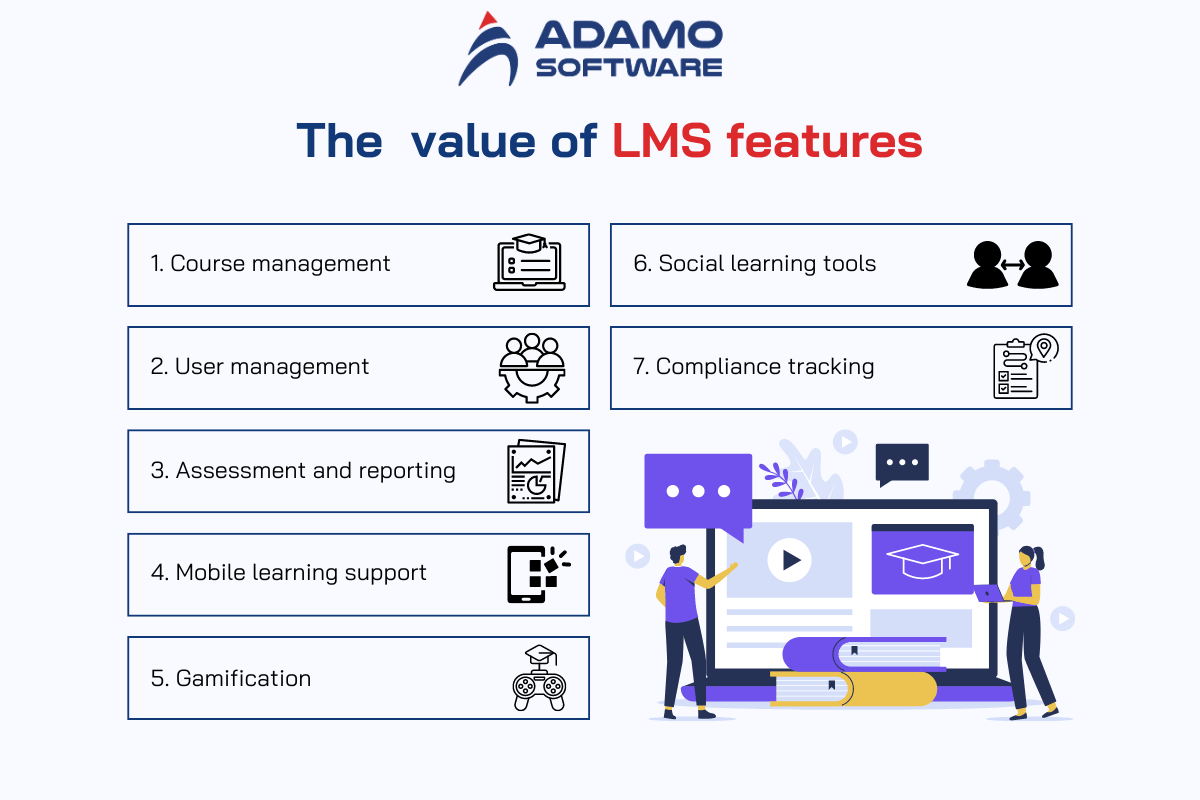
1. Course Management
Course management is a key component of the learning management system. It enables the administrators to develop, categorize, and govern all courses on the platform. With this feature, instructors can upload or create videos, documents, quizzes, and many more that help to develop the entire learning lesson. Course management tools also enable users to organize content and learning materials systematically.
This feature makes the LMS more efficient. It gives administrators control over course structure and delivery. It helps organize learning and ensures learners receive the right content at the right time. It also aids in course modifications and allows administrators to design learning tracks for individuals or groups.
2. User Management
Another important component related to the learning management system is user management. Administrators can manage users, create groups, and assign roles. They can also manage content that meets the learners’ ability levels. This feature is useful in organizing users concerning the roles, departments, or learning needs and therefore enables the delivery of topical training to the correct target group.
Compared to learning content development, with user management, the LMS becomes more of a user-specific experience. Learners receive materials according to their learning level and can review assignments. Administrators can keep track of the learners’ progress and create new training if necessary. This feature also means that only authorized users get to see it, enhancing the level of security and order in learning.
3. Assessment and Reporting
Assessment and reporting are LM essential aspects. It enables instructors to gauge the learners’ understanding of the course. Instructors can monitor each learner’s progress through quizzes, tests, and assignments. Reporting tools give information about the completion of the course, quiz results, and students’ performance.
This feature helps learners stay on track while allowing administrators to track the achievements made in real time. It also makes it easy to realize that learners may experience some difficulties in understanding the lessons. This makes the instructor make necessary changes to improve the situation. Reports also assist organizations in evaluating the efficiency of the training programs in place.
4. Mobile Learning Support
Mobile learning support enables learners to prefer an LMS anywhere and on any device, including smartphones and tablets. This learning management system feature makes eLearning flexible and allows the users to take training materials.
This feature assists the learners to remain interested and fit learning into their daily schedule. Learners can study depending on their timetable, whether they are going to work, traveling, or at home. It also makes the LMS more feasible for the remote staff or those who prefer mobile devices over PCs.
5. Gamification
Most learning management system features are fun and engaging and groom gamification as the learning management system game-like feature. This feature incorporates badges, leaderboards, and awards to increase learners’ participation and make the training more enjoyable.
The application of gamification in the learning process enhances the chances of the learners to complete their courses without halting in the middle. Competition increases user engagement. The leaderboards show how you are doing and how well you are progressing. New and better ways of learning are always more satisfying when they are rewarded. It transforms the learning process into something more engaging. Therefore, it increases interest and performance.
6. Social Learning Tools
Communication features of social learning tools let learners share views, news, or ideas in discussion boards, chat, or collaboration spaces. It encourages learner interaction, allowing them to share their study and ask questions. This fosters collective learning.
This learning management system feature enriches the learning process by allowing learners to share ideas, interact, and teach each other. It creates a sense of togetherness within the LMS and encourages more engagement. Social learning increases training engagement when added to an organization’s training model.
7. Compliance Tracking
Compliance tracking is one of the essential learning management system features. It helps business organizations track employees’ adherence to compliance requirements. Compliance tracking helps the administrators monitor compliance training and certifications. It also addresses the needs of the learners regarding industry standards.
This feature assists an organization in adhering to the set laws and minimizing the possibilities of legal lacunas. It simplifies tracking of the trainees to determine who needs to renew his/her training and when such a need arises. Businesses can monitor changes in regulations to offer the required training to employees.
The decision-making feature promotes the effectiveness of the learning management system. Advantages such as course management, user management, and assessments enhance the learning process and administrative functions. Fun aspects like gamification and social learning comply with analysis to help businesses stay within the legal requirements. Above are the common learning management system features that shape a good and well-functioning LMS for eLearning.
III. Explore the top 30 learning management system features
Selection of an LMS often requires evaluation of different aspects based on the available features. It is important to understand that learning management system features can greatly determine relative usefulness and functionality. In this way, the decisions taken by the businesses and educators are appropriate for providing the best features needed. Next, we shall delve into the 30 best learning management system features to understand how each option improves learning and functionality.

1. Content Creation Tools
One form of multimedia integration is content creation tools, whereby tutors can develop content materials within the context of an LMS. These tools usually provide features for embedding multimedia elements such as videos, quizzes, and other interesting activities.
It also provides powerful features to create content for the most pleasant courses. This feature is used to develop different learning resources. It can be easily modified to keep the content fresh.
2. User Roles and Permissions
User roles and permission determine the level of interaction and visibility a user has on an LMS. Other aspects include the possibility of creating roles as learners, instructors, and managers where each has his/her set of privileges.
User roles and permission enable the management of users and the granting of access as per the user’s preference. It allows users to view and deal only with the content appropriate to his or her level of operation and security.
3. Customizable Branding
Branding can be customized to allow you to change the look of the LMS based on your organization. This includes adding logos, colors, and custom themes, among other features.
Customizable branding gives you the semblance of having a consistent theme, which is very crucial to an organization’s identity. For example, it also offers a user engagement and satisfaction point of view, which is more personalized.
4. Learning Paths
Learning paths are followed to obtain a certain degree, diploma, or other certification, which entails going through several courses or modules in a set order. They assist in an orderly flow of learning experiences, and the learners undergo specific sequences.
Tutorials improve the learning process since learners are provided with directions and targets. This feature helps learners progress systematically, thus making it easier to understand difficult lessons.
5. Integration with Other Tools
Other tools, like HR systems and CRM platforms, allow data sharing between the different systems.
This feature makes it easier to integrate the LMS with other tools, hence making it efficient. For instance, integration with the HR systems helps update employee training records, while CRM helps monitor customer training.
6. Automated Notifications
Some notification features include alerts for important events when a deadline is approaching, or new courses are posted. Notifications can be sent via email through push notification or in the actual application where the game is being played.
Notifications help learners reference and ensure they are on the right page about updates. Automated reports are important as they always update users and do not require further control. Because audiences are known to get bored and lose interest.
7. SCORM and xAPI Compliance
SCORM and xAPI, popularly known as Experience API, are protocols in developing and sharing eLearning courses. Adherence to such standards makes content compatible with various LMS platforms of operation.
Thanks to SCORM and xAPI, content is more flexible and can work on different platforms to integrate any content type. This warrants that courses and the material appear and run well in various systems.
8. Live Classroom Integration
Live classroom integration includes tools enabling virtual classes or meetings to be conducted in real time. It may contain video conference calls, presentations by sharing screens, and even using a whiteboard.
This feature can positively contribute to remote learning as instructors can teach the students in real-time sessions. It assists in dynamic and engaging virtual classrooms, thus improving distance learning.
9. Progress Tracking
Progress tracking keeps track of and provides information on learners’ progress in the different learning courses. It informs learners how far they have progressed with the course and what remains to be accomplished.
Progress tracking provides a progress overview to the learners and the administrators. Incorrect provides a chance for the teacher to correct a learner if he/she is lagging and so everyone is on pace.
10. Analytics Dashboards
Learner analytics and reporting may include analytics dashboards. They present graphical views of learner engagement, performance, and course completion rates. LMS uses it to understand the efficacy of training solutions proposed to the organization.
Dashboards help in the analysis and interpretation of data easily and effectively. They enable the administrators to give adequate and precise improvements on course content based on performance indicators.
11. Gamification
Gamification is a process that involves using elements of game design in learning, more specifically points, badges, and leaderboards. It makes the training even more engaging since employees can match their skills against their fellow employees.
Frequently, gamification enhances the students’ engagement because learning becomes more engaging and fun. They make learners want to engage and meet certain objectives for a particular task since it introduces the aspect of competitiveness. This will encourage learners to go the extra mile to be rewarded for their hard work.
12. Social Learning Tools
Some examples of social learning tools are discussion forums, chat rooms, and group projects. They are used to incite people-to-people and peer cooperation in learning.
They improve learning as learners interact with fellow learners and share knowledge. When learning is socially focused, learners can also develop togetherness and learn from others’ experiences.
13. Mobile Compatibility
Mobile compatibility follows the need to ensure that the LMS can operate effectively on smartphones and similar devices. This feature allows one to access this site conveniently on several devices.
Mobile compatibility enables learners to take courses and learn materials from the comfort of their mobile devices at their convenience. This is because it is flexible and convenient and promotes learning on the go, thus enhancing access.
14. Customizable Reports
Flexible reporting tools allow the user to have comprehensive reports that are more personalized according to the requirements or tastes of the user. It is up to the individual to include and how this data will be presented.
Such reports allow administrators to pay attention to specific details by adding useful learning management system features. It enables improved data analysis and is the best point for attacking the sources of the problem.
15. E-commerce Integration
E-commerce integration enables students to purchase the course or access the learning content directly from the LMS. It supports payment gateways and shopping cart solutions.
This feature benefits organizations that wish to generate revenues through sales of the training material content. It also eases the sale of courses and, more importantly, the transaction process within the specific LMS.
16. Certificate Generation
Certificate generation is an aspect of the automated issuance of certificates once a learner completes the course. Specific branding and course details can be added to certificates, which people can get once they complete the course.
Certificates give learners an acknowledgment of the skills that they have attained. This feature makes it easier for certification to be given and for certification tracking, which is a plus regarding the interests of learners and employers.
17. Advanced Search Functionality
The search bar can filter content or courses and provide more sophisticated options depending on the LMS. It has washed scrubs to remove page selections and refine a search.
With advanced search, it would be easier for the users to filter and find the most appropriate resources. Essentially, this increases the overall usability of the LMS. Thereby, it enhances the ability of learners and administrators to search for information.
18. Multi-language Support
Supporting multiple languages enables an LMS to be operational in different languages. This feature is advantageous for companies having users from all around the world.
Multiple language support means people from different areas can learn in the LMS in their local languages. It improves usability and accommodativeness, thus proposing LMS to be more versatile globally.
19. Interactive Content
Examples of interactive content are the ones whereby the learner is active; some are quizzes, simulations, and activities. This feature makes learning more engaging, and people can be active in their learning process.
All in all, learners pay more attention to the content and retain more knowledge than traditional one-way communication. It makes the learning setting more active and can enhance recall by enhancing how knowledge is acquired.
20. Role-Based Access Control
Role-based access control also enables the administrators to decide on the access a given user should have by identifying their role. It will enable users to access only those sections or features related to their responsibilities.
This feature makes it more secure and increases its organization by preventing the accessibility of such space. Keep data consistency and ensure that some users can execute some functions only.
21. API Integration
API enables LMS to interact with other software and systems, known as Application Programming Interface integration. API portals enable platforms to transfer data and share functionalities.
API integration is the process of linking the LMS with other tools and services to extend the function of the LMS. They make it possible for data to flow well and optimize the general working of activities.
22. Single Sign-On (SSO)
Single Sign On (SSO) enables the users to sign into the LMS with credentials from another system, such as a corporate network. It also makes work easier as it eliminates the need to remember many passwords, as with this login procedure.
SSO also has the benefit of increasing the simplicity of a login process. It also improves security as the system consolidates the authentication process. Thereby, it cuts the risk of coming across a password problem.
23. Accessibility Features
These features ensure that individuals with physical disabilities can also use the LMS. This is due to the development of accessibility features like screen readers, keyboard navigation, and other tools.
The accessibility feature ensures LMS is friendly to learners with disabilities, where everyone has an equal chance of benefiting from the content uploaded. They also aid in ensuring that accessibility standards are met, besides promoting an equal learning environment.
24. Backup and Recovery
Data protection is done by creating a backup and recovery of a system copying the data and offering options for data retrieval in a system failure.
This feature is important to reduce the chances of losing learning data owing to various issues in the system. It ensures that in incidents such as fire outbreaks, one can easily recover the content and information relating to the users.
25. User Feedback Tool
Users feedback tools are designed to capture and handle information that the learners may have concerned their experience with the LMS. This may comprise LS, rankings, and comments.
Such feedback capture tools assist in the determination of the entire learner experience. This information can be used to develop changes beneficial to the LMS and the general satisfaction levels.
26. Scheduled Reporting
Canned reports enable administrators to develop standard periodic reports generated and issued at specific intervals.
Automated reporting reduces the time used in preparing the reports since they are prepared in advance. It ensures that reports are produced and distributed to the administrators, so they can be updated on an organization’s performance.
27. Content Library
A content library is accumulated as a repository of course material, resources, and documents. It means it is easy to have a wider and easier way of accessing learning material.
The content library helps organize and find such learning resources. It also caters to the arrangement of content and ensures that any material used in the learning process by instructors and learners is well provided.
28. Virtual Reality (VR) Integration
Virtual reality (VR) is an integration where a virtual reality learning environment includes virtual reality simulations. The advantages of VR integration are the features of providing highly realistic and interactive learning experiences.
It is useful in the learning process in the most effective fields when the trainees are exposed to as many actual-life situations as possible.
29. Collaboration Tools
Some collaboration tools are group workspaces, file sharing, and team collaboration projects. This makes them assist in sharing ideas, communication, and cooperation among the learners.
There are tools to support the work of groups that include group learning and project work. They enable learners to cooperate, exchange information and objects, and improve the learning process.
30. Customizable Dashboards
Personalized interfaces can be mainly provided through widgets and interface elements. It lets users customize their homepage, or dashboard, giving users the capability to view content relevant to their needs.
Filtering results and creating individually tailored interfaces help people prioritize the information they are interested in. This feature makes it easier to use and enables Les to concentrate on the most important tasks.
Knowledge of these learning management system features is critical to selecting the right LMS. Each of these learning management system features has its relevance in supporting and improving the functionalities. Prioritizing such features, businesspeople, and educators can filter to an LMS that best fulfills their intended objectives in delivering proper eLearning solutions.
IV. How to choose a LMS for your business
Selecting the right LMS is an important necessity for any eLearning solution to be effective. Every business or institute has different needs, and the LMS should be adaptable to all these needs of the business institution. Here’s a step-by-step guide to help you make the best choice:

1. Identify Your Learning Goals
First, consider whether the content is for employees’ training or raising students’ knowledge. Determine the learning activities you will have to facilitate, and the results required of the learners.
This is important to be guided by your learning goals when deciding on the best LMS to acquire. For instance, if your organization requires powerful reporting tools for corporate training, such elements of the LMS shall be considered top priorities.
2. Determine Your Must-Have Features
Specify the must-have functionalities in your LMS to base the requirements for your learning management system. This could be content creation, service distribution, or compatibility with mobile devices. Consider what is relatively important to your training or educational programs.
The urgency of the features helps in eliminating choices since the selection targets the most desirable features. For instance, if mobility is considered relevant for your learners, ensure that the LMS you choose has good mobile compatibility and a user-friendly interface.
3. Consider Scalability
Check whether you can develop your business or institute along with the LMS. Other attributes to consider include its ability to accommodate more users, more content, and more complex operations when needed.
Scalability allows LMS to adapt to new changes without being affected when your organization expands. This means that a scalable system can adapt to new users’ growth and changing training needs without having to be redesigned.
4. Assess User Experience
Consider how easy it is for both the administrator of the LMS and the learner for effective use of the LMS. This ranges from the accessibility of the site, its design, and even how easy it is to locate anything. An LMS should be easy to use so that the various users will not require special instructions on how to use it.
A good user experience enhances the use of the application by the user, resulting in less time, effort, and money spent during the learning process. When users are satisfied with its ease of use, administrators and learners will be most likely to utilize the system properly.
5. Review Support and Updates
Determine the extent of customer support provided by the LMS provider. Ensure they offer enough support by responding to different options for communication, including email, phone, or chat. Furthermore, ensure the LMS is updated and upgraded now and then.
Good support means your LMS stays smooth and is always updated with the latest features and security releases. This prevents technical problems with the system and thus sustains the effectiveness of the system.
6. Evaluating and testing platforms
It is crucial for demo testing before making the last call on which LMS to select. The majority of the LMS providers have free trials or demonstrations that can be taken. Find out from other users’ feedback their experience and satisfaction levels with the system.
The pilot implementation enables the user to use the LMS and to find out how it works in the operations. Listing and reading the reviews helped you understand the efficiency and reliability of the LMS from other users’ experiences.
7. Additional Considerations
Technical Requirements: Make sure that the LMS that you’ll be choosing integrates with your current systems and environments. Deliverable aptitude is therefore checked to reflect low implementation technicalities.
Customization Options: Investigate how flexible the LMS is for your company’s, as well as your, needs and preferences. This ranges from branding, modes of structuring distinct courses, and interfaces that the users interact with.
Choosing the best LMS entails the consideration of some aspects of a given learning management system. From the goals, the features that are needed, and the user experience and support, an organization can select the right LMS for it. These are learning management system features you should consider while selecting an LMS.
Also read: Explore Top 8 Healthcare Learning Management System Software for Practical Users
V. How can Adamo Software help?
Adamo Software is a bespoke Learning Management Systems (LMS) solutions provider. Our core competence is to offer customized LMS solutions that suit your business’s requirements. Understanding the specific learning management system features that will be most beneficial for your business. It allows us to be your perfect partner in designing a solution that addresses your needs.
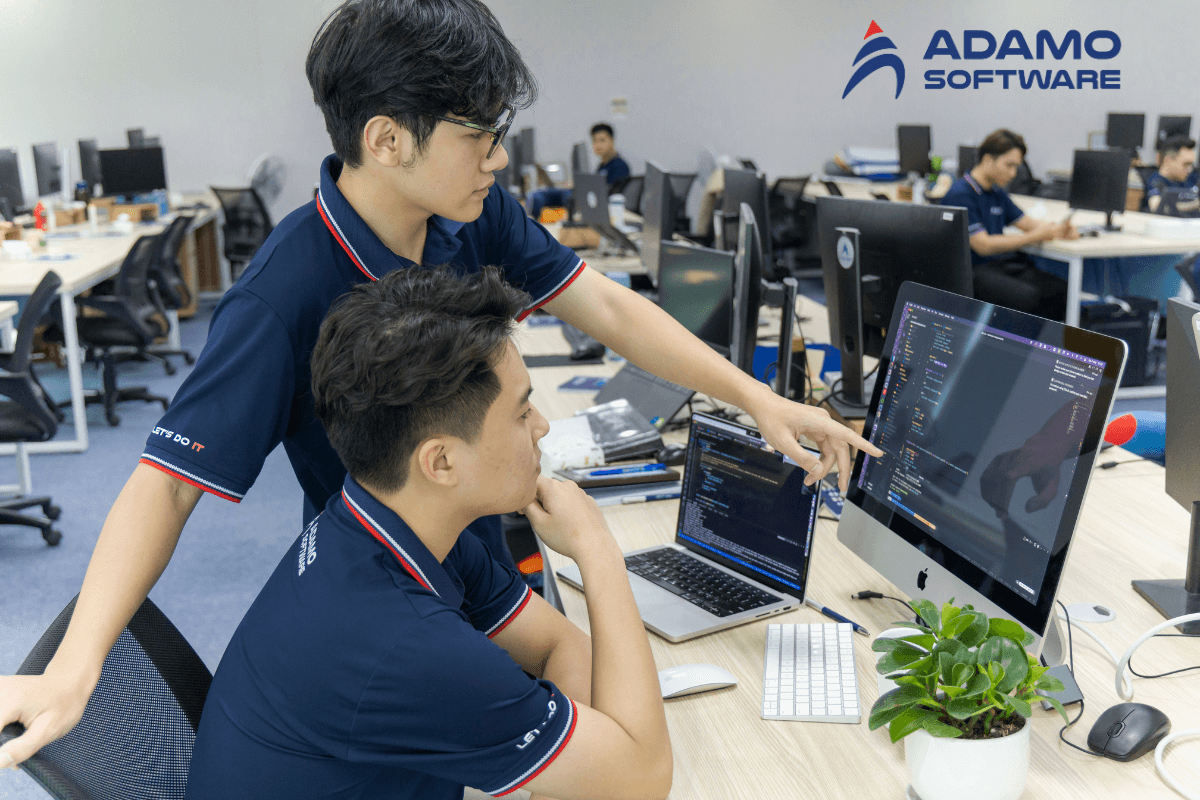
Special solutions for different kinds of companies
Adamo Software has been backed by several successful experiences working with various industries. No matter whether you need an LMS for corporate training, educational institutions, or any other purpose, we serve the purpose best. We have created unique LMS systems with extended functionalities. These systems are designed for large corporations with complex analytical and reporting needs. They also cater to educational establishments requiring various tutorials and individual student profile management.
Tailored Learning Management System Features
Adamo Software’s team collaborates with you to create an LMS that contains the features of the learning management system essential to your organization. Every company is unique and requires special approaches. Some may need enhanced content production tools. Others might require easily extensible user management. Integration with other programs may also be necessary. In this regard, we make it possible for an LMS to contain all the necessary features if it is meant for training employees or used for academic purposes.
Advantages of Making a Business Deal with Adamo Software
The following are benefits that come with teaming up with Adamo Software. We deal with various solutions that can be customized to suit the changing needs of your business. No customer needs to fend for themselves because our team is always available. We ensure that your LMS is fully equipped with the latest technologies and features as they are developed. We also provide you with profound knowledge of up-to-date LMS technologies, thus keeping you on-trend.
All in all, Adamo Software is ready to assist you in developing an individual LMS that will meet the needs of your enterprise. We guarantee that your LMS runs efficiently and works as a pedagogical tool to achieve your intended learning and development objectives.







